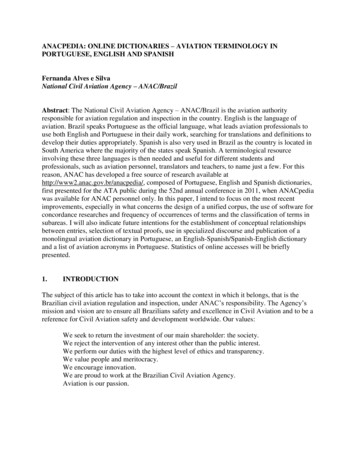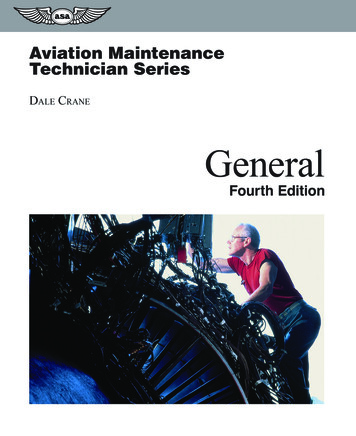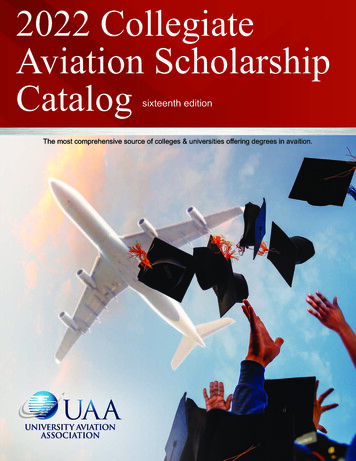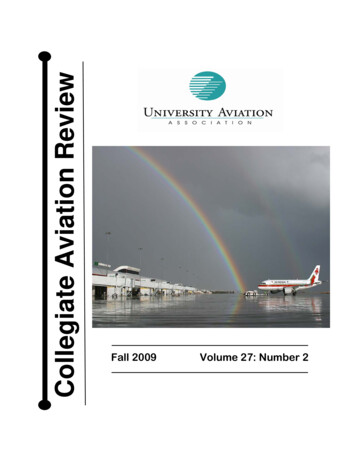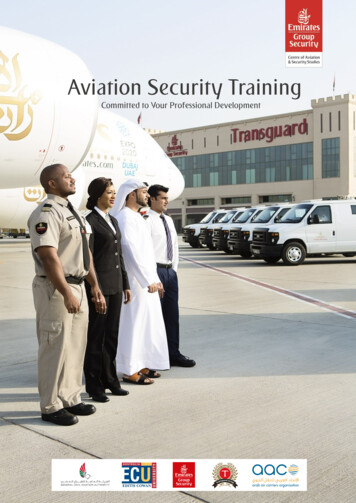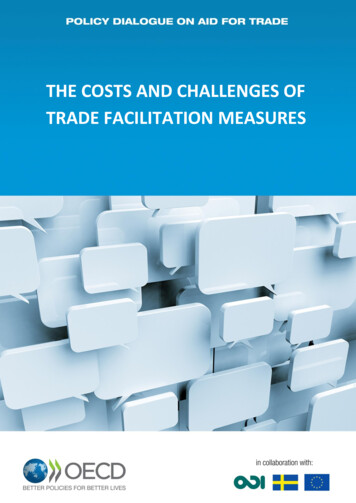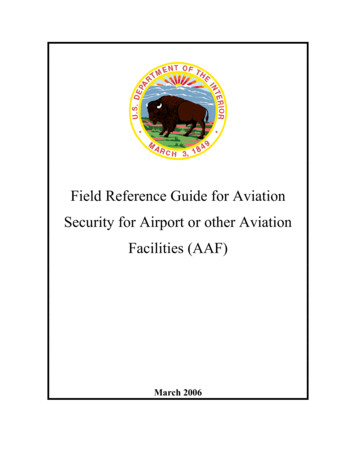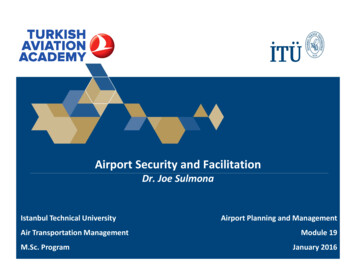
Transcription
SECFAL PDG/3-WP/210/04/2018International Civil Aviation OrganizationAviation Security and Facilitation Plan Development GroupThird Meeting (SECFAL PDG/3)(Kuwait, 8 – 10 May 2018)Agenda Item 2:AVSEC/FAL Global and Regional DevelopmentsLATEST DEVELOPMENTS ON AVIATION SECURITY AND FACILITATIONAT THE GLOBAL AND REGIONAL LEVELS(Presented by the Secretariat)SUMMARYThis paper presents the latest developments in Aviation Security and Facilitation atthe Global and Regional levels.Action by the meeting is at paragraph 3.REFERENCES-1.Annex 17 – Security amendment 15Annex 9 – Facilitation amendment 26Africa and Middle East Aviation Security Roadmap, endorsed bythe Ministerial Conference on Aviation SecurityDGCA-MID/4Dubai Declaration on Cyber Security in Civil AviationGlobal Aviation Security Plan (GASeP)The Riyadh Declaration on Aviation Security and Facilitation in the ACACand ICAO MID RegionsUSAP-CMA, Analysis of Audit Results, reporting period ending31 December 2017INTRODUCTION1.1The Global Ministerial Aviation Summit was held in Riyadh, Kingdom of SaudiArabia, 29 - 31 August 2016. The Riyadh Declaration on Aviation Security and Facilitation in theACAC and ICAO MID Regions at Appendix A was signed on 31 August 2016.1.2The Dubai Declaration on Cyber Security in Civil Aviation at Appendix B wassigned during the Summit on Cybersecurity in Civil Aviation held in Dubai, United Arab Emiratesfrom 4 to 6 April 2017.1.3The Africa and Middle East Aviation Security Roadmap at Appendix C, wasendorsed by the Ministerial Conference on Aviation Security (Sharm El Sheikh, Egypt, 22-24 August2017); it forms the basis for the work to be carried out by the relevant regional AVSEC/FAL Groups,in line with the Global Aviation Security Plan (GASeP).
SECFAL PDG/3-WP/2-21.4The fourth meeting of the Directors General of Civil Aviation (DGCA-MID/4) heldin Muscat, Oman, 17-19 October 2017, through Conclusion 4/8 established the Middle East RegionalAviation Security and Facilitation Group (MID-RASFG).1.5The Global Aviation Security Plan (GASeP) was approved at the seventh meeting ofICAO Council in its 212th Session on 10 November 2017.2.DISCUSSION2.1The latest amendment 15 of Annex 17 – Security and amendment 26 of Annex 9 –Facilitation introduced new/revised provisions on Landside Security, Behavioral detection, Innovationin aviation security and Man-Portable Air Defense Systems (MANPADs), Risk Assessment, CyberSecurity and Advanced Passenger Information (API). The provisions of these amendments were alsointegrated in the GASeP, as of November 2017.2.2The GASeP identified five key priority outcomes where ICAO, States andstakeholders should focus their attention, resources and efforts. These priorities are derived from themain challenges that may face member States which are: Enhance risk awareness and response. Understanding risk is essential for policiesand measures that are effective, proportionate and sustainable. Undertaking riskassessments will help to identify gaps and vulnerabilities, which can then beurgently addressed in the most practical way possible, and with optimal use ofresources. Develop security culture and human capability. The promotion of effectivesecurity culture is critical to achieve good security outcomes. A strong securityculture must be developed from the top management across and within everyorganization. The existence of a well-trained, motivated and professional workforce is a critical prerequisite for effective aviation security. Improve technological resources and foster innovation. Promoting and applyingbetter technological solutions and innovative techniques can provide the tools forenhancing security effectiveness while ensuring operational efficiency. Improve oversight and quality assurance. Effective quality control and oversightprocesses globally, nationally, and locally are critical in delivering sustainedeffective aviation security. Increase cooperation and support. Increasing collaboration between and withinStates will enable the key security objectives to be achieved more quickly andefficiently.2.3Recalling further the ICAO Assembly Resolution A39-19: Addressing Cybersecurityin Aviation, and the importance and urgency of protecting civil aviation’s critical infrastructure,systems and data against cyber threats. The Dubai Declaration on Cyber Security in Civil Aviation,declared that States and ICAO work to ensure the early entry into force and universal adoption of theBeijing Instruments, as called for in ICAO Assembly Resolution A39-10: Promotion of the BeijingConvention and Beijing Protocol of 2010; and Reiterate States commitment to the development of arobust, efficient and sustainable civil aviation system.
SECFAL PDG/3-WP/2-32.4From the Riyadh Declaration on Aviation Security and Facilitation in the ACAC andICAO MID Regions, the following is to be highlighted:“Incorporate the provisions of the Global Aviation Security Plan (GASeP and the Global FacilitationPlan after their endorsement by ICAO’s Assembly in the Regional SECFAL Plan”).2.5priorities.The Africa and Middle East Aviation Security Roadmap that incorporated the GASeP2.6The four priorities which have been identified by the SECFAL PDG/2 are: Cyber Security; Risk & Threat Assessments (Land & Airspace); Cargo & Mail Security; and Passenger Data (API/PNR).2.7Based on the results of the USAP-CMA (Second Cycle), the Average EI of CE forthe MID Region as of 31 December 2017 is 69.64%, which is below the Global Average EI of CE(72.62%). While the average EI of CE for the Five (5) MID States that had been audited under theUSAP-CMA is 90.55. According to the Second Cycle results, the lowest results for MID States arerelated to CE 7 and CE 8, which mainly relates to oversight and quality control activities with relationto empowerment of staff and enforcement of regulations to close any non-compliance or occurrence.While the results also show that MID Region is doing excellent in the documentation and oversightareas compared with the implementation area.3.3.1ACTION BY THE MEETINGThe meeting is invited to:a) note the recent developments at the global and regional levels; andb) ensure that the MID SECFAL Plan as well as the MID-RASFG work programmeare in line with the Riyadh Declaration, Dubai Declaration, the Africa and MiddleEast Aviation Security Roadmap and the GASeP.----------------------
SECFAL PDG/3-WP/2APPENDIX ARIYADH DECLARATIONON AVIATION SECURITY AND FACILITATIONIN THE ACAC AND ICAO MID REGIONS
GLOBAL MINISTERIAL AVIATION SUMMIT31 AUGUST 2016 - RIYADH, KINDGOM OF SAUDI ARABIARIYADH DECLARATIONON AVIATION SECURITY AND FACILITATIONIN THE ACAC AND ICAO MID REGIONS
RIYADH DECLARATION ONAVIATION SECURITY AND FACILITATIONIN THE ACAC AND ICAO MID REGIONS31 AUGUST 2016We, Ministers and Head of Delegations responsible for Civil Aviation in the Arab Civil AviationCommission (ACAC) and ICAO Middle East (MID) Regions, meeting in Riyadh, Kingdom of Saudi Arabia,on 31 August 2016, on the occasion of the ”Global Ministerial Aviation Summit” organized by theKingdom of Saudi Arabia:A. MINDFUL OF1.The Convention on International Civil Aviation done in Chicago on 7 December 1944;2.The Convention on Offences and Certain other Acts Committed on board Aircraft signed atTokyo on 14 September 1963 (Tokyo Convention); and the Protocol to Amend the Conventionon Offences and Certain other Acts Committed on board the Aircraft adopted by the ICAODiplomatic Conference on 4 April 2014 (Montreal Protocol);3.The Convention for the suppression of Unlawful Acts against the Safety of Civil Aviation, adoptedin Montreal on 23 September 1971;4.The Protocol for the Suppression of Unlawful Acts of Violence at Airports Serving InternationalCivil Aviation adopted in Montreal on 24 February 1988;5.ICAO Assembly Resolution 38-15: Consolidated statement of continuing ICAO policies related toaviation security adopted by the 38th Session of the ICAO Assembly;6.The ICAO Comprehensive Aviation Security Strategy (ICASS);7.The proposal for ICAO to establish a Global Aviation Security Plan (GASeP), to be considered bythe 39th Session of the ICAO Assembly;8.The Declaration on Aviation Security adopted by the 37th Session of the ICAO Assembly;9.The Convention on the Prevention and Combating of Terrorism adopted in Algiers on 14 July 1991and which entered into force on 6 December 2012;10.The Arab League Charter adopted on 22 March 1945;11.The Arab Convention to Combat Terrorism adopted in Cairo in March 1998;3
12.The Bagdad Declaration for the Suppression of Unlawful Acts Against the Safety of the CivilAviation adopted in Bagdad in October 1989;13.The Resolution 404 adopted during the 27th meeting of Arab Ministers of Transport on22 – 23 October 2014 in Alexandria – Egypt;14.The Sharm El Sheikh Declaration adopted on 29 March 2015 on Maintenance of Arab NationalSecurity against Current challenges;15.The Arab League Council Agreement to establish the Arab Civil Aviation Commission in February1996;16.The Joint Statement adopted on 11 April 2012 during the ICAO Regional Conference on AviationSecurity held in Manama – Bahrain;17.The Rabat Declaration on Border Security of 14 November 2013;18.The Joint Communiqué on 17 April 2014 of the ICAO – WCO Joint Conference on Enhancing AirCargo Security and Facilitation held in Manama – Bahrain;19.The latest edition of the Risk Context Statement developed by ICAO AVSEC Panel and adoptedby ICAO in April 2016;20. The Memorandum of Cooperation (MOC) signed between the ACAC and ICAO on28 September 2010;21.The establishment of Cooperative Aviation Security Programme Middle East (CASP-MID) on 19January 2013;22. The results of the ICAO Universal Security Audit Programme - Continuous Monitoring Approach(USAP-CMA);23. The various programmes, objectives and targets currently being pursued under ICAO’s NoCountry Left Behind (NCLB) initiative; and24. The ICAO Traveler Identification Programme (TRIP) Strategy, the importance and complexitiesof identity management and the global migration towards Machine Readable Travel Documents(MRTD) and ePassports.B. CONSIDERING AND REAFFIRMING1.The importance of air transport in the economic development of States, particularly its effecton economic growth and job creation;2.The importance of aviation security and facilitation in air transport industry developmentworldwide and its impact on growth of the air transport sector, particularly in the ACAC andMID Regions;4
3.The compelling need to continuously enhance aviation security and facilitation in the Arabworld and the need to urgently find immediate and sustainable resolutions to deficiencies inaviation security and facilitation;4.The administrative, financial, legal, operational and technical challenges which may impede theresolution of such deficiencies;5.The urgent need to implement national and regional strategies on aviation security andfacilitation in the ACAC and ICAO MID Regions with a view to promoting aviation as a vital modeof transport which enhances the Regional development and integration; and6.The role of ICAO in fostering the development of international civil aviation.C. COMMENDINGACAC and ICAO for their continued technical assistance to the ACAC and ICAO MID Member States;D. CONCERNED BY1.Recent aviation security terrorist attacks as well as the threat and risk outlook facing internationalcivil aviation;2.Challenges in safeguarding international civil aviation in a demanding aviation securityenvironment;3.The need to adequately empower the designated Appropriate Authority for aviation securityoversight at the national level;4.The continuous need to improve States’ capacity and capability to address the tenuous securityenvironment, conflict zones, and new and emerging threats;5.The need to enhance States’ Level of Effective Implementation of the critical elements of anaviation security oversight system, compliance with the ICAO aviation security - and facilitationrelated Standards and Recommended Practices (SARPs) in Annexes 17 and 9 to the ChicagoConvention, and implementation of States’ Corrective Action Plans;6.The need to foster development of effective National Programmes: National Civil AviationSecurity Programme (NCASP), National Civil Aviation Security Training Programme (NCASTP),and National Civil Aviation Security Quality Control Programme (NCASQCP) and National AirTransport Facilitation Programme (NATFP);7.Insufficient functioning of the National Aviation Security and Air Transport FacilitationCommittees, and the challenges faced in establishing a national coordination mechanism forfacilitation and aviation security;8.The negative consequences of a weak aviation security and facilitation culture;5
9.The need to enhance guidance and training for aviation security and facilitation personnel inorder to increase the number of competent/skilled professionals;10.Challenges in harmonization and intensification of assistance and capacity-building efforts;11.Lack of effective implementation of the ICAO TRIP Strategy;12.Low level of States’ participation in the ICAO Public Key Directory (PKD);13.Insufficient systems and tools for the efficient and secure reading and verification of MachineReadable Travel Documents (MRTDs) at borders, including the use of the ICAO PKD and theINTERPOL Stolen and Lost Travel Documents (SLTD) database; and14.Slow pace of the implementation of aviation security and facilitation requirements of SecurityCouncil Resolution 2178 (2014), including the use of Advance Passenger Information (API).E. WELCOMINGThe various initiatives undertaken by sector organizations and partners in the ACAC and ICAO MIDRegions;F. UNDERTAKE TO1.Ensure political commitment at the international, regional, sub-regional and national levels foraviation security and facilitation;2.Meet States’ aviation security and facilitation obligations under the Convention on InternationalCivil Aviation, including the assurance of effective aviation security oversight;3.Ensure that aviation security is given its due consideration in States’ National DevelopmentPlans and is recognized as integral to national security;4.Accelerate the establishment and strengthening of Appropriate Authorities with sufficientindependent regulatory oversight for aviation security;5.Ensure the provision of sustainable funding and other resources to carry out effective aviationsecurity oversight and implementation of aviation security and security-related facilitationmeasures;6.Ensure the implementation of the provisions of ICAO Annexes 17 and 9 related to the establishmentof National Civil Aviation Security Committees (NCASC) and National Air Transport FacilitationCommittees (NATFC);7.Ensure the development of sustainable national programmes within the States, includingNational Civil Aviation Security Programme (NCASP), National Civil Aviation Security TrainingProgramme (NCASTP), National Civil Aviation Security Quality Control Programme (NCASQCP)and National Air Transport Facilitation Programme (NATFP);6
8.Ensure the timely resolution of all Significant Security Concerns (SSeCs) and deficienciesidentified through the Universal Aviation Security Audit Programme – Continuous MonitoringApproach (USAP-CMA);9.Ensure the availability and retention of sufficient and competent/skilled aviation security andfacilitation professionals;10.Coordinate with relevant authorities to conduct risk assessments on the threats affecting civilaviation;11.Cooperate and collaborate internationally, regionally, sub-regionally and bilaterally to shareinformation, as well as to provide technical assistance;12.Promote and facilitate the sharing of Cyber Threat Indicators and Defensive Measures;13.Promote the sharing of specific risk and threat assessments addressing surface-to-air concerns,such as Man Portable Air Defense Systems (MANPADS);14.Promote regional and sub-regional cooperation in the field of aviation security and facilitationtraining;15.Urge States manufacturing facilitation and aviation security equipment and software to removeall restrictions on selling and exporting such equipment and software to protect civil aviationagainst acts of unlawful interference;16.Take steps to professionalize the roles of Aviation Security Managers and Officers;17.Support operators when requested by foreign regulators to implement secondary measures atlast points of departure;18.Enhance cargo security through fostering implementation of Secure Supply Chain Concept,including the implementation of Regulated Agent and Known Consignor schemes, and the useof e-Consignment Security Declarations (CSD);19.Promote the adoption of “One-Stop-Security” Concept through fostering the implementation ofbilateral agreements for mutual recognition of security measures between States;20. Ensure effective implementation of aviation security and facilitation requirements of SecurityCouncil Resolution 2178 on 24 September 2014, including the use of Advance PassengerInformation (API) in line with international Standards as set by ICAO;21.Ensure the inclusion of the INTERPOL Stolen and Lost Travel Document (SLTD) Database screeningsolutions within the regional, sub-regional and national aviation security and facilitation plans;22. Support and encourage the extension of the INTERPOL Secure Global Communication System(I-24/7) beyond National Central Bureaus (NCBs) and more importantly to Border Control Pointsfor access and effective use of the SLTD Database;23. Ensure the coordination with relevant authorities for the removal of all non-Machine ReadablePassports (MRP) from circulation;7
24. Increase the effective use of the ICAO Aviation Security Point of Contact (PoC) network for realtime information sharing;25. Promote the use of self-service options at airports to increase throughput of passengers andreduce crowding in vulnerable areas; and26. Urge States› implementation of the ICAO TRIP Strategy and encourage States’ participation inthe ICAO Public Key Directory (PKD).G. DECIDE TO1.Adopt the Riyadh Declaration on Aviation Security and Facilitation in the ACAC and ICAO MIDRegions;2.Support, provide and make available needed resources for the development of a RegionalSECFgAL Plan which aims to enhance aviation security and facilitation in the ACAC and ICAOMID Regions and for the implementation of the Declaration;3.Direct the ACAC Secretariat, in coordination with the ICAO Secretariat, to establish an effectivemonitoring, evaluation and reporting mechanism for this Declaration through the creation of ajoint Steering Committee, including all stakeholders which will establish and maintain a clearaction plan with specific targets towards the establishment of a regional SECFAL Group.4.Take the necessary steps to sign and ratify all international conventions on aviation securityand facilitation, if not already done;5.Incorporate the provisions of the Global Aviation Security Plan (GASeP) and the Global FacilitationPlan after their endorsement by ICAO’s Assembly in the Regional SECFAL Plan; and6.Encourage States that have not yet participated in the Cooperative Aviation Security ProgrammeMiddle East (CASP-MID) to do so as CASP-MID’s role is foreseen to evolve in line with theformulation of a Regional SECFAL plan to foster collaboration among States and concernedstakeholders. The plan would include collaborative mechanisms on matters that are agreedglobally such as information sharing and training in addition to matters specific to the Regionwhich will be identified by the Joint Steering Committee.H. MAKE A SOLEMN APPEALto the ICAO, the United Nations Economic Commission, the Islamic Development Bank (IDB), the ArabFund for Economic & Social Development, the World Bank (WB) and all civil aviation developmentpartners and organizations to support the aviation security and facilitation programmes of the ACACand ICAO MID Regions.Done and adopted in Riyadh, Kingdom of Saudi Arabia on 31 August 2016.8
SECFALPDG/3-WP/2 CAPPENDIXAFRICA AND MIDDLE EASTAVIATION SECURITY ROADMAPGASeP: The Roadmap to foster AviationSecurity in Africa and the Middle EastSharm El Sheikh, Egypt, 22-24 August 2017
1.The Africa and Middle East Aviation Security Roadmap, endorsed by the Ministerial Conferenceon Aviation Security (Sharm El Sheikh, Egypt, 22-24 August 2017) forms the basis for the workto be carried out by the relevant regional AVSEC/FAL Groups, in line with the Global AviationSecurity Plan (GASeP).2. of the Roadmap sets out aviation security actions/tasks, responsibilities, andprojected outcomes under the following six (6) key priorities:-Enhance risk awareness and assessment;Develop security culture;Develop human capability in Aviation Security;Improve technological resources and encourage innovation;Improve oversight and quality control; andIncrease regional cooperation and support3.Most of the above-mentioned key priorities are derived from the Global Aviation Security Plan(GASeP), which was reviewed by the ICAO Council at the seventh meeting of its 211th Sessionon 16 June 2017, and transmitted to States and international organizations on 11 July 2017 forcomments.4.This Roadmap is a “living” document aligned with the GASeP, and takes into consideration thefollowing AVSEC Declarations endorsed in the AFI and MID Regions: Windhoek Declaration on Aviation Security and Facilitation, endorsed on7 April 2016Riyadh Declaration on Aviation Security and Facilitation, endorsed on31 August 2016 in Riyadh, Kingdom of Saudi ArabiaDubai Declaration on Cyber Security, endorsed on 4 April 2017 in Dubai, UnitedArab Emirates5.The main objective of the AFI and MID AVSEC Roadmap is to assist and encourage AFI andMID States and stakeholders to work collaboratively towards effective implementation of agreedactions/tasks to achieve the objectives of the GASeP. The AFI and MID AVSEC Roadmap wouldbring the States and stakeholders in a holistic and coordinated effort to strengthen regional andinter-regional collaboration in aviation security.6.With all States and stakeholders fulfilling their responsibilities relative to the Roadmap, thesustained level of secure and safe civil aviation operations would contribute towards preventinghuman, economic, financial and other losses. A strengthened aviation system would provide aconducive environment for economic growth and development in the AFI and MID States.7.Page 1 of the Roadmap should be reviewed and updated in a coordinated manner by the
relevant Regional AVSEC/FAL Groups, through the ICAO Regional Offices taking into accountspecific regional existing and emerging aviation security threats, as well as the GASeP and itsfuture amendments.8.The relevant Regional AVSEC/FAL Groups, taking into consideration the provisions of theabove-mentioned Declarations and the available resources of States, should develop detailedAction Plans to ensure the effective implementation of the Roadmap.9.In support of the ICAO “No Country Left Behind” initiative, States should endeavour to provideassistance in implementing the Roadmap, as necessary, to other States in need.10.States should determine and implement the relevant actions/tasks in a prioritized mannerconsidering their greatest areas of risk. In order to assist with this prioritization, States may obtaininformation from the ICAO Global Risk Context Statement, ICAO USAP audit results, andfeedback from the Regional Offices accredited to AFI and MID States.11.The relevant Regional AVSEC/FAL Groups will work with the ICAO Regional Officesaccredited to the AFI and MID States to collaborate with their States, international and regionalOrganizations, and industry stakeholders to support the effective implementation of the Roadmap.12.The relevant Regional AVSEC/FAL Groups will work with the ICAO Regional Officesaccredited to the AFI and MID States to monitor the implementation of the Roadmap and provideperiodic progress reports to the relevant bodies, based on the feedback received from Statesregarding the implementation of the Roadmap.The Ministers responsible for Aviation in Africa and the Middle East undertake to ensure the actions areimplemented in all States in accordance with the detailed action plans to be developed by RegionalAVSEC/FAL Groups: . Understanding risk is essential for policies andmeasures that are effective, proportionate and sustainable. Undertaking risk assessments will help toidentify gaps and vulnerabilities, which can then be urgently addressed in the most practical way possible,and with optimal use of resources. . The promotion of effective security culture is critical to achieve goodsecurity outcomes. A strong security culture must be developed from the top management across andwithin every organization. . The existence of a well-trained, motivated andprofessional work force is a critical prerequisite for effective aviation security. . Promoting and applying bettertechnological solutions and innovative techniques can provide the tools for enhancing securityeffectiveness while ensuring operational efficiency. . Effective quality control and oversight processesglobally, nationally, and locally are critical in delivering sustained effective aviation security. . Increasing collaboration between and within Stateswill enable the key security objectives to be achieved more quickly and efficiently.Page 2
PRIORITYENHANCE RISKAWARENESS ANDASSESSMENT AFI and MID AVSEC ROADMAP - Priority Areas, Tasks and OutcomesACTIONS/ TASKSRESPONSIBILITYPROJECTED OUTCOMEPromotion of risk awareness through workshops andseminarsReview of reports of the USAP CMA audit results todetermine prevailing deficienciesPerform national and regional risk assessments to determinethreat level.Identify cybersecurity threats and formulate mitigationmeasuresDEVELOPSECURITYCULTUREDEVELOP HUMANCAPABILITY INPage A-1ICAO, States,IndustryICAO, StatesStates and RegionalAVSEC/FALGroupsStates, IndustryEffective security risk assessment methodologyestablished by States.Enhanced Effective implementation of CriticalElements of State Security oversight systems(EI)Effective implementation of preventive securitymeasuresCybersecurity mitigating measures put in placeEvaluate emerging risks associated with Remotely PilotedAircraft Systems (RPAS).ICAO, States,IndustrySecure RPAS operations are achieved andmaintainedEvaluate threats associated with MANPADS risksICAO, StatesMeasures to mitigate risks associated withMANPADS put in placeMeasures to mitigate risks associated withLandside security threats put in placeIdentify and implement measures to counter possible threatsrelated to landside securityStatesPut in place mitigating measures against insider threatsStatesPromote development of security awareness programmes thateffectively promote a positive security cultureICAO, States,IndustryEnsure that the national programmes for quality control haveprovisions to effectively monitor implementation of securityculture.Encourage reporting culture in all security related incidentsby all stakeholdersStatesStates, IndustryMeasures to mitigate risks associated withinsider threats put in placeSeminars, conferences and courses are organized,as appropriateSecurity awareness programmes are developedand incorporated in NCASTP for implementationSecurity culture enhancedEffective allocation of security resourcesAVSEC incidents are promptly reportedConsider the possibility of introducing incentives for thosewho provide information on security incidentsStatesReduction in security incidentsEnsure sufficient funding is provided for a robust, trained andmotivated security workforces.StatesWork force professionalizedImproved work performance
CES ANDENCOURAGEINNOVATIONIMPROVEOVERSIGHT ANDQUALITY CONTROLINCREASEREGIONALCOOPERATION ANDSUPPORTPage A-2ACTIONS/ TASKSRESPONSIBILITYEncourage Aviation Security Training centers (ASTCs) toshare resources including curriculum development,instructors and exchange programmesSupport development of training material on new andemerging threatsConduct outreach activities to promote the use of appropriatetechnology, including human factors considerationsEstablish detailed threat identification for each type ofsecurity equipmentAssess available technologies for each type of securityequipmentSupport the implementation of the Windhoek Ministerialtargets and action plan (Short, medium and long term)Support the implementation of the Riyadh Ministerial targetsand action plan (Short, medium and long term)Establish a framework to enable rectification of gapsidentified under USAP-CMA and implement immediateresponse measuresAnalyse national quality control data to identifyimplementation issues that are systemic and require attentionat a foundational levelEncourage the development of action plans and identificationof possible channels of assistance, training or knowledgetransfer in support of USAP-CMA auditsCoordinate the implementation of the various regionaldeclarations in the field of aviation securityEncourage participation by and support from the RegionalBodies to implement AVSEC projectsSolicit support from African Union Commission and itstechnical body for Aviation securityEnsure that a Regional Database of aviation security trainingcentres and experts is established and maintained by theRegional AVSEC/FAL GroupsEncourage implementation of UNSC Resolution 2309 (2016)and GASeP’s objectives/Roadmap to local entities involvedin AVSECICAO, AATO,StatesICAO, States,IndustryICAO, States,IndustryStatesStates, IndustryICAO, States,industryICAO, States,industryStatesStatesICAO, States,industryICAOICAO, RegionalBodiesICAO, ACACAFCAC, --PROJECTED OUTCOMEOptimal utilization of resourcesImprovement in quality of trainingEffective implemen
1. Recent aviation security terrorist attacks as well as the threat and risk outlook facing international civil aviation; 2. Challenges in safeguarding international civil aviation in a demanding aviation security environment; 3. The need to adequately empower the designated Appropriate Authority for aviation security oversight at the national .
